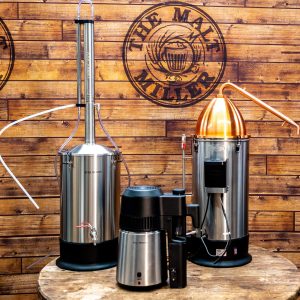Unraveling the Art of Distillation: Pot Distilling vs. Reflux Distilling
Introduction
Distillation is an age-old process that has played a significant role in producing various spirits and liquors throughout history. It is a technique that allows the separation of components in a liquid mixture based on their boiling points. Among the various distillation methods, two prominent approaches stand out: pot distillation and reflux distillation. In this blog post, we will delve into the fundamental differences between these two methods, exploring their unique characteristics, strengths, and applications.

1. Pot Distillation
Pot distillation is the traditional and classic method of distilling spirits, used for centuries to craft whiskey, brandy, and other artisanal liquors. The process involves the use of a simple alembic or pot still, which is composed of a large copper pot, a swan neck, and a condensing coil. The pot still is heated, and the liquid mixture (usually a fermented mash) is added to the pot.
The distillation process begins when the pot is heated, causing the liquid to evaporate. The vapor rises through the swan neck and enters the condensing coil, where it cools and condenses back into liquid form. The condensed liquid, now enriched with alcohol and aromatic compounds, is collected as the distillate. The distillation process in a pot still is usually done in one pass, resulting in a spirit with a robust flavor profile and distinct characteristics.
Advantages of Pot Distillation:
a. Complexity of Flavor: Pot distillation allows for a wide range of volatile compounds to pass through the distillation process, contributing to a complex and rich flavor profile. This is highly valued in whiskey and brandy production.
b. Retaining Congeners: Congeners are compounds other than ethanol that contribute to the flavor, aroma, and mouthfeel of spirits. Pot distillation retains a higher concentration of congeners, imparting depth and character to the final product.
c. Artisanal Appeal: Pot distillation is often associated with craft distilleries and small-batch production, appealing to consumers seeking unique and handcrafted spirits.
2. Reflux Distillation
Reflux distillation is a more modern and sophisticated distillation technique that has gained popularity in recent decades, particularly in the production of neutral spirits like vodka and gin. Unlike pot distillation, reflux distillation employs a column still, which is a tall vertical column filled with plates or packing material.
The process begins by heating the liquid mixture at the base of the column. As the vapor rises through the column, it encounters cooler surfaces, such as condenser coils or packing materials, causing partial condensation. This condensed liquid, known as reflux, flows back down the column, and the process repeats. The reflux serves to redistill the vapor, separating impurities and producing a higher purity distillate.
Advantages of Reflux Distillation:
a. High Purity: Reflux distillation allows for a more precise separation of components based on their boiling points. This results in a higher purity distillate, making it ideal for producing neutral spirits that require a clean and smooth taste.
b. Control over Congeners: The reflux process enables distillers to control the concentration of congeners, making it easier to produce spirits with a consistent flavor profile.
c. Efficiency: Reflux distillation is generally more efficient than pot distillation, as it enables multiple distillation stages within a single run, saving time and energy.
3. Application and Spirit Types
The choice between pot distillation and reflux distillation depends on the type of spirit being produced and the desired characteristics of the final product.
a. Pot Distillation Applications:
Pot distillation is preferred for spirits that benefit from a diverse flavor profile and a robust character. Whiskey, brandy, rum, and some artisanal gins are commonly produced using pot distillation. The aim is to retain the unique qualities of the raw materials and the fermentation process.
b. Reflux Distillation Applications:
Reflux distillation is commonly used for producing neutral spirits, such as vodka and some types of gin. In these spirits, the goal is to achieve a high level of purity, removing most of the congeners and impurities to create a clean and smooth taste.

Conclusion
In conclusion, both pot distillation and reflux distillation are valuable techniques in the art of distillation, each offering distinct advantages suited for specific types of spirits. Pot distillation excels in creating complex and flavorful liquors, while reflux distillation focuses on producing high-purity spirits. Both methods contribute to the diversity and richness of the world of spirits, appealing to different palates and preferences. Whether it’s the earthy notes of a pot-distilled whiskey or the crisp purity of a reflux-distilled vodka, the art of distillation continues to evolve, enriching our drinking experiences and celebrating the craft of distillers worldwide.
For further information on all things small scale distilling then check out the awesome “Still It” YouTube Channel or why not pick up a copy of “How To Distill” By Aaron Hyde

